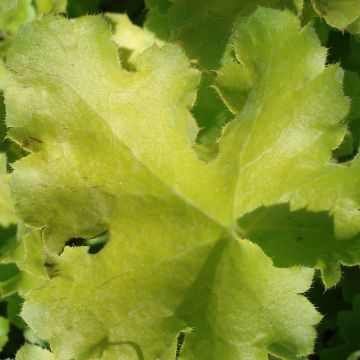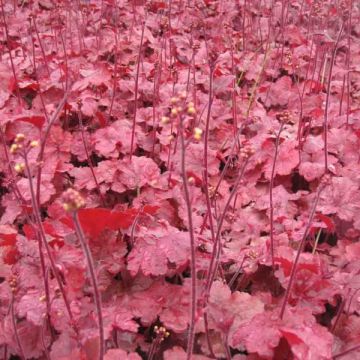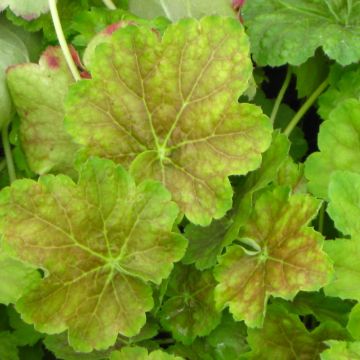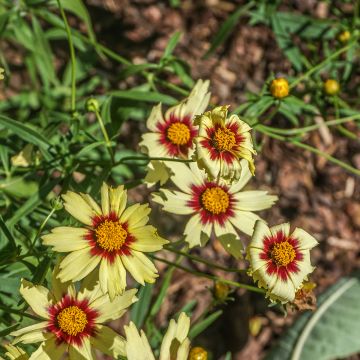Shipping country and language
Your country of residence may be:
Your country of residence is:
For a better user experience on our website, you can select:
Your shipping country:
Andorra
Austria
Belgium
Bulgaria
Canada
Chile
Croatia
Cyprus
Czechia
Denmark
Estonia
Finland
France
Germany
Greece
Hungary
Iceland
Ireland
Italy
Latvia
Lithuania
Luxembourg
Malta
Monaco
Netherlands
Poland
Portugal
Romania
Slovakia
Slovenia
Spain
Sweden
Switzerland
United Kingdom
We only deliver seed and bulb products to your country. If you add other products to your basket, they cannot be shipped.
Language:
French
German
Spanish
English
My Account
Hello
My wish lists
Plantfit
Log in / Register
Existing customer?
New customer?
Create an account to track your orders, access our customer service and, if you wish, make the most of our upcoming offers.


Heuchère, Heuchera parviflora var. nivalis


Heuchère, Heuchera parviflora var. nivalis
Heuchera parvifolia var. nivalis
Heuchera parvifolia var. nivalis
Coral Bells, Alumroot
Why not try an alternative variety in stock?
View all →Order in the next for dispatch today!
Dispatch by letter from €3.90.
Delivery charge from €5.90 Oversize package delivery charge from €6.90.
More information
This item is not available in your country.
Schedule delivery date,
and select date in basket
This plant carries a 12 months recovery warranty
More information
We guarantee the quality of our plants for a full growing cycle, and will replace at our expense any plant that fails to recover under normal climatic and planting conditions.
From €5.90 for pickup delivery and €6.90 for home delivery
Express home delivery from €8.90.
Does this plant fit my garden?
Set up your Plantfit profile →
Description
Heuchera parvifolia var. nivalis is a rarely grown botanical species, and undoubtedly one of the smallest in the genus. This miniature plant offers an unusual appearance and its cultivation method is also very different from the varieties usually grown in our gardens. This perennial plant forms a cushion of tiny round light green leaves that do not have lobes but are very fringed, from which very airy stems of small white flowers emerge in spring; these are delicate and adorned with slightly prominent, almost transparent stamens. This species grows well in both sunny and shaded places, prefers well-drained soils, and tolerates heat and summer drought well.
Heuchera parvifolia var. nivalis, not to be confused with Heuchera parviflora var. parviflora, is a caudex plant in the saxifrage family, native to North America. It is found growing on rocky outcrops in valleys, foothills, canyon walls, and subalpine and alpine meadows between 1200 and 3900 m (4,000 and 13,000 ft) in altitude. It is found in various states such as Arizona, Colorado, Idaho, Montana, Nevada, New Mexico, Utah, and Wyoming.
This small heuchera forms a mound of evergreen foliage not exceeding 15 cm (6 in) in height, spreading over 20 to 30 cm (8 to 12 in) in diameter. Its thick, rounded, light green leaves are no larger than a thumbnail and have scalloped edges. Flowering takes place from May to July depending on the climate, in the form of thin stems, 30 to 70 cm (12 to 28 in) tall, bearing at their extremity a narrow spike 5 cm (2 in) in length, composed of yellowish-green to off-white flowers, with an orange throat, not exceeding 1 cm (0.4 in) in length, including the stamens. The stamens turn orange when ripe. This plant is perfectly hardy and self-seeds spontaneously when it is happy, giving rise to colonies of dozens of individuals.
Very tolerant of heat and drought, this curious little heuchera is planted in groups, in shaded or semi-shaded rockeries, on the edges of undergrowth, and can even be used on green roofs in the company of sedums, for example. It will also coexist with alpine plants such as saxifrages and Strobilanthes penstemonoides, as well as epimediums or perennial geranium macrorrhizum Spessart. It will also look beautiful planted among mossy stones.
Heuchera parvifolia var. nivalis in pictures






Flowering
Foliage
Plant habit
Botanical data
Heuchera
parvifolia var. nivalis
Saxifragaceae
Coral Bells, Alumroot
North America
Other Heuchera
Planting and care
Heuchera, Tiarella, Mitella, Tolmiaea, Tellima, etc., are all perennial plants, very close to each other, all originating from North America, and all equipped with excellent hardiness. Heucheras in general like a moist, damp soil, but one that is rich in humus, in the shade or semi-shade. This is not the case, however, with Heuchera parvifolia var. nivalis, this curious species from the alpine steppes. It instead requires a very well-drained, rather fertile soil that is sandy or gravelly, and tolerates heat and relative summer drought very well. Heuchera parvifolia var. nivalis will grow equally well in full sun, semi-shade or even full shade. Heucheras are irreplaceable in borders of woodland beds where their foliage often remains evergreen in winter and their small size allows them to occupy the foreground.
Planting period
Intended location
Care
This item has not been reviewed yet - be the first to leave a review about it.
Ground cover perennials
Haven't found what you were looking for?
Hardiness is the lowest winter temperature a plant can endure without suffering serious damage or even dying. However, hardiness is affected by location (a sheltered area, such as a patio), protection (winter cover) and soil type (hardiness is improved by well-drained soil).

Photo Sharing Terms & Conditions
In order to encourage gardeners to interact and share their experiences, Promesse de fleurs offers various media enabling content to be uploaded onto its Site - in particular via the ‘Photo sharing’ module.
The User agrees to refrain from:
- Posting any content that is illegal, prejudicial, insulting, racist, inciteful to hatred, revisionist, contrary to public decency, that infringes on privacy or on the privacy rights of third parties, in particular the publicity rights of persons and goods, intellectual property rights, or the right to privacy.
- Submitting content on behalf of a third party;
- Impersonate the identity of a third party and/or publish any personal information about a third party;
In general, the User undertakes to refrain from any unethical behaviour.
All Content (in particular text, comments, files, images, photos, videos, creative works, etc.), which may be subject to property or intellectual property rights, image or other private rights, shall remain the property of the User, subject to the limited rights granted by the terms of the licence granted by Promesse de fleurs as stated below. Users are at liberty to publish or not to publish such Content on the Site, notably via the ‘Photo Sharing’ facility, and accept that this Content shall be made public and freely accessible, notably on the Internet.
Users further acknowledge, undertake to have ,and guarantee that they hold all necessary rights and permissions to publish such material on the Site, in particular with regard to the legislation in force pertaining to any privacy, property, intellectual property, image, or contractual rights, or rights of any other nature. By publishing such Content on the Site, Users acknowledge accepting full liability as publishers of the Content within the meaning of the law, and grant Promesse de fleurs, free of charge, an inclusive, worldwide licence for the said Content for the entire duration of its publication, including all reproduction, representation, up/downloading, displaying, performing, transmission, and storage rights.
Users also grant permission for their name to be linked to the Content and accept that this link may not always be made available.
By engaging in posting material, Users consent to their Content becoming automatically accessible on the Internet, in particular on other sites and/or blogs and/or web pages of the Promesse de fleurs site, including in particular social pages and the Promesse de fleurs catalogue.
Users may secure the removal of entrusted content free of charge by issuing a simple request via our contact form.
The flowering period indicated on our website applies to countries and regions located in USDA zone 8 (France, the United Kingdom, Ireland, the Netherlands, etc.)
It will vary according to where you live:
- In zones 9 to 10 (Italy, Spain, Greece, etc.), flowering will occur about 2 to 4 weeks earlier.
- In zones 6 to 7 (Germany, Poland, Slovenia, and lower mountainous regions), flowering will be delayed by 2 to 3 weeks.
- In zone 5 (Central Europe, Scandinavia), blooming will be delayed by 3 to 5 weeks.
In temperate climates, pruning of spring-flowering shrubs (forsythia, spireas, etc.) should be done just after flowering.
Pruning of summer-flowering shrubs (Indian Lilac, Perovskia, etc.) can be done in winter or spring.
In cold regions as well as with frost-sensitive plants, avoid pruning too early when severe frosts may still occur.
The planting period indicated on our website applies to countries and regions located in USDA zone 8 (France, United Kingdom, Ireland, Netherlands).
It will vary according to where you live:
- In Mediterranean zones (Marseille, Madrid, Milan, etc.), autumn and winter are the best planting periods.
- In continental zones (Strasbourg, Munich, Vienna, etc.), delay planting by 2 to 3 weeks in spring and bring it forward by 2 to 4 weeks in autumn.
- In mountainous regions (the Alps, Pyrenees, Carpathians, etc.), it is best to plant in late spring (May-June) or late summer (August-September).
The harvesting period indicated on our website applies to countries and regions in USDA zone 8 (France, England, Ireland, the Netherlands).
In colder areas (Scandinavia, Poland, Austria...) fruit and vegetable harvests are likely to be delayed by 3-4 weeks.
In warmer areas (Italy, Spain, Greece, etc.), harvesting will probably take place earlier, depending on weather conditions.
The sowing periods indicated on our website apply to countries and regions within USDA Zone 8 (France, UK, Ireland, Netherlands).
In colder areas (Scandinavia, Poland, Austria...), delay any outdoor sowing by 3-4 weeks, or sow under glass.
In warmer climes (Italy, Spain, Greece, etc.), bring outdoor sowing forward by a few weeks.
























